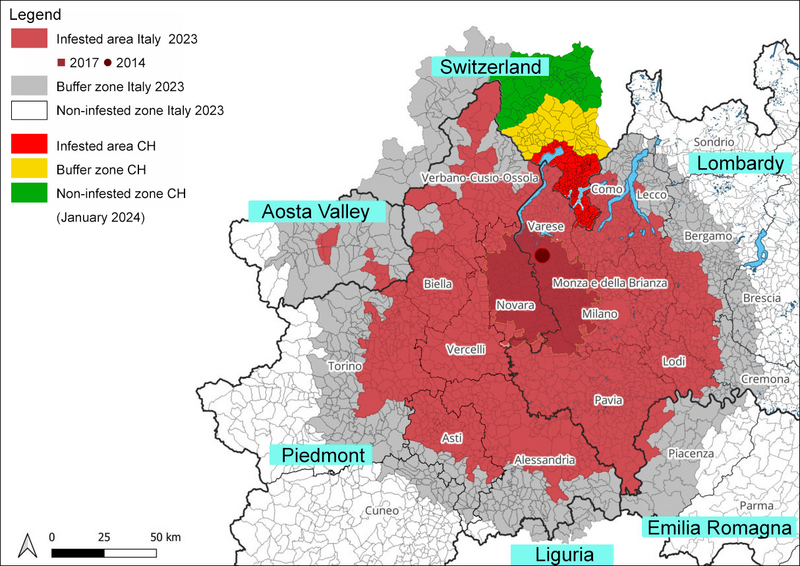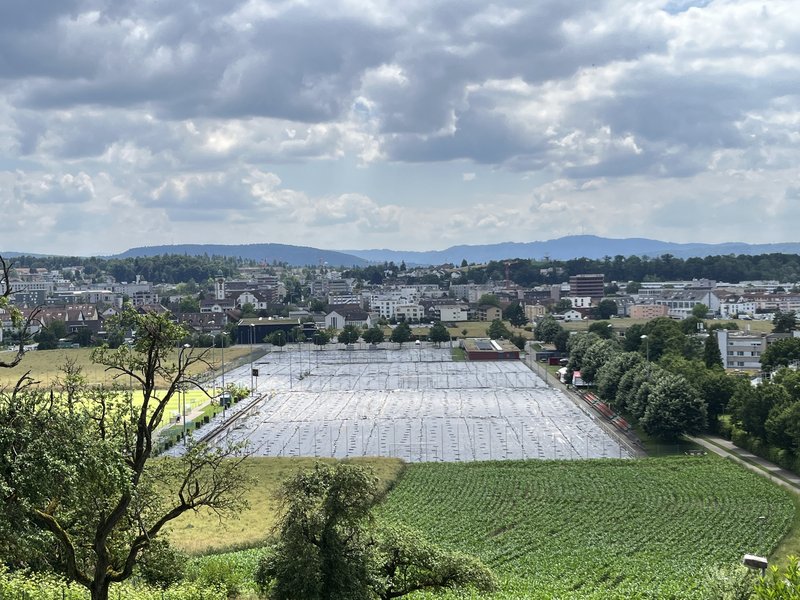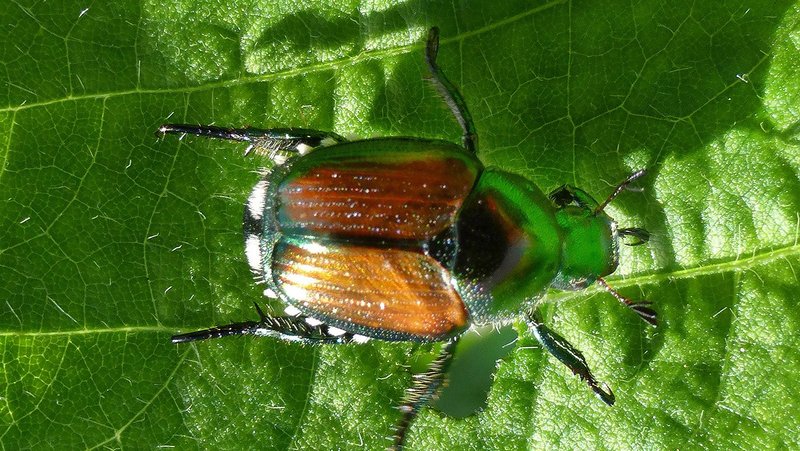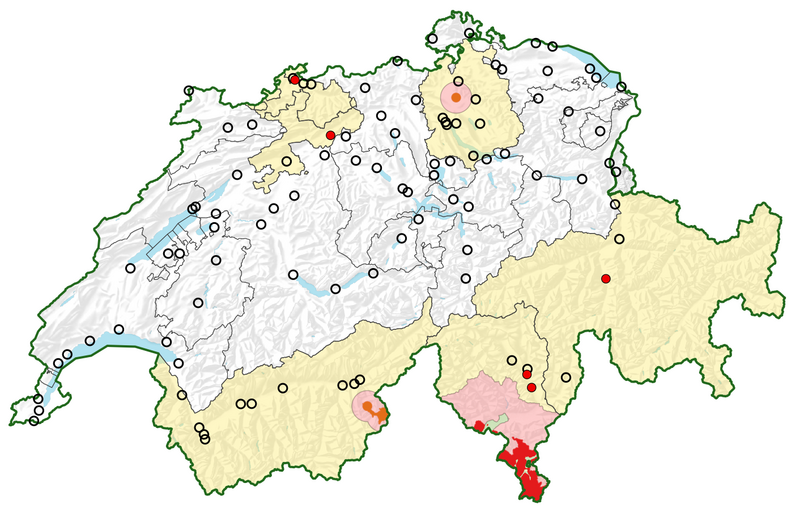The Japanese beetle (Popillia japonica) originally comes from Asia. In Europe, it was first detected in Italy in 2014. It has since spread mainly through being transported on various means of transport. The Japanese beetle can be recognised by the five white tufts of hair on each side of the abdomen, the two white tufts on the last abdominal segment and the striking, metallic-green shimmering neck shield (pronotum, fig. 1).
Legal situation in Switzerland
It is assumed that the Japanese beetle could become established throughout Switzerland - at least in the valleys up to 900 metres above sea level. The consequences of its uncontrolled spread are difficult to estimate. However, there is a risk that the economic damage could turn out to be as high as it has been in the USA. Switzerland is doing everything it can to prevent this from happening: since 2020, area monitoring has been carried out in all cantons, using attractant traps for the early detection and control of the Japanese beetle.
Fig. 2. Area monitoring Switzerland (as of 2023). Source: Agroscope.
● catches | ○ no catches
▣ infestation zone* | ▣ centre of infestation* | ▣ buffer zone*
▣ cantons with additional monitoring*
* not all trap locations shown
Legal framework in Switzerland
The Japanese beetle is considered a priority quarantine organism in Switzerland and the EU, and any infestation must therefore be reported and controlled. As the beetle is primarily considered an agricultural pest, legal responsibility lies with the Federal Office for Agriculture FOAG (Plant Health Ordinance PGesV-WBF-UVEK).
Any suspected infestation must be reported to the Cantonal Plant Protection Services. In addition, the Japanese beetle is monitored by the Swiss Federal Plant Protection Service (SPPS) as part of the plant passport control system and the risk-based import control of plants and plant products. The companies authorised to issue plant passports report suspected cases to the SPPS.
- For private individuals: what to do in the event of a suspicious find
Situation of established wild populations in Italy, southern Switzerland and Valais
On the European mainland, this invasive beetle species was first found in Italy in 2014, near Milan in the Parco del Ticino. The Japanese beetle was probably introduced there by aeroplane via Malpensa Airport, and it has succeeded in becoming established in the region. This has led to various control measures and research projects. The beetle has now also been recorded in traps in the Aosta Valley (motorway service station), in Sardinia (near the airport), and in the Emilia-Romagna region. By the end of 2023, an area of more than 14,257 km2 including buffer zones was affected in Italy. Eradication measures include the installation of more than 4,800 traps, as well as the implementation of training programmes, public relations campaigns, and special regulations for the export of plants with soil.

Fig. 3. Map showing distribution of the Japanese beetle in northern Italy (status as of October 2023) and southern Switzerland (status as of January 2024). Since 2014, the infested area has been expanding by around 7-10 km per year. Source: Phytosanitary and Technical Scientific Services Sector Piedmont Region and KPSD TI (modified).
The Cantonal Plant Protection Service (KPSD TI) began precautionary monitoring on the Ticino side of the border with Italy in 2015. Fortunately, the three traps along the Swiss border remained free of beetles for the first two years. The Japanese beetle was first detected in 2017 in the traps set up on the Swiss border near Stabio (24 beetles). Eradication measures began immediately, and the number of traps on the Swiss side was steadily increased: to seven traps in 2017, 10 traps in 2018 (154 catches), 13 traps in 2019 and 28 traps in 2020 and 2021. By 2022 there were 265 traps. Additional visual inspections were carried out from 2021. Finds reported by the public are also important (around 300 reports in 2023). In Ticino, it has been shown that the number of specimens caught in traps has increased tenfold each year.
The first actual outbreak in the wild in Ticino was detected in 2020. Since the spread of the Japanese beetle in Ticino can no longer be controlled locally, a containment strategy has been in place since 2021. A containment zone was established in southern Ticino as early as 1 December 2020 to prevent the further spread of the beetle. This containment zone is updated annually. The Federal Office for Agriculture (FOAG) has issued a General Ruling that sets out the protective measures against the spread of the Japanese beetle (Popillia japonica Newman) in detail.
Since 2020, Switzerland has been operating a national area monitoring system for the early detection of infestation foci of the Japanese beetle. The control measures to be implemented in the event of the appearance of this pest are outlined in detail in FOAG Guideline No. 7 “Monitoring and control of the Japanese beetle Popillia japonica Newman” (PDF, Agroscope). As part of this mandate, numerous traps baited with special attractants are set up between mid-June and the end of September in all Swiss cantons at risk locations, such as motorway service stations, markets, freight yards, wetlands, public green spaces and logistics centres (129 traps by 2022).
At new infestation sites, initial attempts are made to eradicate the infestation by collecting and destroying the beetles. Once the beetle species has become established, eradication is often no longer possible. Then - as in 2020 in Ticino – a containment zone is designated and a programme of containment is instigated in accordance with BLW Guideline No. 7.
In 2023, an established population was also discovered on the Swiss side in the canton of Valais, bordering the infested areas in Italy, prompting the canton to initiate the relevant monitoring measures. The eradication measures include a ban on the movement of soil and green waste, as well as the inspection of clothing, luggage and vehicles in transit. Due to the high infestation pressure from Italy, a containment strategy is also being pursued here.
Swiss infestation history – an overview
Year | Canton | Event |
| 2017 | Ticino/Tessin | First detection of Japanese beetles in the area-monitoring traps in Ticino along the border with Italy. In the years that followed, the monitoring resulted in further catches, and numerous findings were reported by the public or in the course of visual inspections. |
| 2020* | Ticino/Tessin | First outbreak in Ticino. As it is no longer possible to eradicate the infestation, a containment strategy has been pursued since the end of 2020. |
| 2021 | Basel-Stadt | A single, live beetle was captured for the first time outside the canton of Ticino. Extended monitoring revealed no further findings. |
| 2022 | Solothurn | Again, a single beetle was discovered in a surveillance trap Finding near Olten-Neuendorf, presumably a “stowaway” that had been transported across the Alps from the south with the movement of people or goods. |
| 2022 | Ticino/Tessin | Individual findings of beetles outside the infestation and buffer zone |
| 2023* | Zurich | First outbreak on the northern side of the Alps. An infestation area and a buffer zone were designated, in which insecticides were used and a ban on irrigation was imposed. |
| 2023* | Wallis | Findings in the two municipalities of Zwischbergen and Simplon in the Upper Valais: the Japanese beetles are thought to have migrated independently from the infestation area in northern Italy. |
| 2023 | Grisons | Single find of a beetle in a monitoring trap. |
| 2024* | Basel-Stadt and Basel-Landschaft | Several beetles caught in monitoring traps. Here there is a further established population north of the Alps. The surveillance monitoring programme has been expanded. A turf producer and grass football pitches have been particularly affected. |
| 2024* | Schwyz | 8 beetles found in monitoring traps near Arth-Goldau. One of the methods used to control this population is the distribution of nematodes in a radius of 300 metres around the sites where beetles have been found. |
| 2024* | Solothurn | 5 beetles discovered in monitoring traps near the Gunzgen motorway service station. As in the canton of Schwyz, the release of nematodes is intended to prevent the larvae (grubs) of the beetle from surviving in the soil and emerging and spreading further next year. |
| 2024* | Valais | As in Ticino, a containment strategy is being pursued in Valais. |
| 2024 | various cantons | Various individual finds - so-called “hitch-hikers” - in the surveillance traps set up throughout Switzerland. |
| * bold = established population, not just individual specimens found | ||
Japanese beetle population in the canton of Zurich
In mid-July 2023, four beetles were caught in an attractant trap in Kloten (ZH) in the course of a nationwide monitoring programme for the Japanese beetle. The Cantonal Plant Protection Service then set up further traps, and checked potential host plants within a radius of one to three kilometres for beetles and signs of feeding. Their efforts showed that there is already a small population of the Japanese beetle in Kloten. That makes it the first established population on the northern side of the Alps.
Eradication measures were initiated immediately. Since mid-July 2023, the entire municipal area of Kloten has been considered a centre of infestation. Adjacent to this is a buffer zone with a radius of seven kilometres from the site of the find. Pest control measures have been taken in these zones to prevent the females from laying their eggs in the soil and thus the rapid reproduction of the beetle.
To prevent further spread, additional traps have been installed, and host plants such as roses, fruit trees and berry bushes were specifically treated with insecticides up to the end of July 2023. These measures affected both public green spaces and private gardens. A ban on watering lawns and green spaces was in force in Kloten until the end of September 2023, to prevent eggs being laid in damp soil. Green waste, compost, plants with roots, and soil material were no longer allowed to be transported out of the infested zone. A ban on the transport of green waste also applied in the buffer zone until the end of September.
In June 2024, however, another beetle was found in a monitoring trap, so that bans on the transport of green waste and excavated soil and on watering in the affected areas also applied from June to September 2024. In July 2024, 1500 beetles were captured in the area of a sports facility. According to the Building Department of the Canton of Zurich, it was possible to prevent the flight of many beetles by spreading overlapping strips of silage foil (fig. 4) over the area. To prevent the infestation from spreading on to the airport site, trees and bushes on public land in the infested area and on green strips along the motorway and in front of the airport were sprayed once with insecticide in July.
You will find further information on this infestation here (in German).

Fig. 4. Silage film used in Kloten in 2024 to cover the turf at a sports facility. On the one hand this prevented larvae from developing to the end stage due to food deprivation and fully developed beetles from hatching, and on the other hand, there was no access to the pitches for further egg laying. Photo: Fiona Eyer (Strickhof, Plant Protection Service)
Basel-Stadt and Basel-Landschaft
In 2021, a single Japanese beetle was found in a monitoring trap in Basel-Stadt. The subsequent increased monitoring did not reveal any further beetle finds.
In 2023, two beetles were found in monitoring traps in the canton of Basel-Landschaft, whereupon monitoring was intensified.
In 2024, several beetles were again found in the same monitoring trap in the canton of Basel-Landschaft. This is the second separate, established population north of the Alps. The surveillance was immediately extended both here and throughout the city of Basel. This time a rolled turf producer and football pitches were particularly affected. The turf on the areas was rotary cultivated and removed, and the area was then covered with large plastic sheets. This was intended to destroy the larvae and pupae of the beetles and prevent adult beetles from flying out. At the same time, the film prevented further egg-laying on these areas. Similar measures were also successfully implemented in the infested area in Zurich in 2024.
You will find further information on this here (in German).
Reporting finds and preventing spread
For the Japanese beetle to be controlled effectively, it must be detected early enough.
If you find a suspicious beetle: take a photo of it, catch it and store it in a closed container, such as a jar with a screw-on lid, and inform the Plant Protection Service immediately!
In Switzerland, you can report finds to the Plant Protection Service responsible in the relevant canton.
If you are staying in infested areas such as Ticino, Valais or northern Italy: Please check any items of luggage (rucksacks, bags, suitcases, camera bags, etc.), the vehicle and any pets you are travelling with carefully for beetles before you return. Beetles could have attached themselves somewhere as “stowaways” using the little hooks on their legs, so that you could unwittingly transport them to another area.
Do not be tempted to take any plants in soil – such as roses – home with you as souvenirs from the infested areas of northern Italy, Ticino or Valais, as eggs, larvae or grubs of the Japanese beetle could be concealed in them. These can then hatch as beetles in the garden at home and spread there.
When camping, please make absolutely sure when packing up your tents and other camping equipment that you do not inadvertently pack up any beetles and take them away with you.
Situation in Europe
The Swiss authorities maintain constant contact with their colleagues in neighbouring countries so that they are up to date on the situation close to the border in particular, and can react quickly if necessary. The monitoring of traps is carried out in close coordination, and experiences are discussed annually.
The distribution area of the quarantine pest in Italy is shown in Figure 3.
In Baden-Württemberg (Germany), there has also been surveillance monitoring with pheromone traps since 2016, mostly in the vicinity of major traffic arteries. Between 2021 and 2023, a few individual beetles were found in monitoring traps in the Freiburg im Breisgau region. It is thought that these may have been introduced by rail transport from an infested area in Italy. Individual beetles were also found in traps in Weil am Rhein in 2022 and 2023. In addition to the normal monitoring traps on transport routes such as motorways and at railway freightyards, monitoring in these two areas has been intensified. In 2024, some beetles were again found in Freiburg and the district of Ludwigsburg. Further information on this can be found here (in German).
There had previously also been reports of individual specimens found in the federal states of North Rhine-Westphalia (2014) and Bavaria – near the Austrian border (2018) and from surveillance traps on motorways in 2024. Despite several years of monitoring in some areas, no evidence of an established population has yet been found there (see EPPO).
In Slovenia a beetle was found in a monitoring trap in July 2024. The appropriate monitoring measures have been initiated (see EPPO).
Translation: Tessa Feller




![[Translate to English:] [Translate to English:]](/assets/_processed_/6/0/csm_wsl_alb_europa_weiss_e3f367e50a.jpeg)